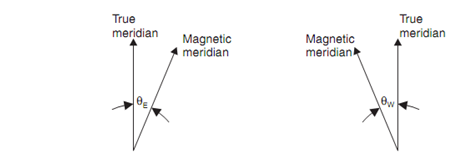DECLINATION
In a place the magnetic meridian and the true meridian cannot coincide with each other. The horizontal angle between these 2 meridians is called as magnetic declination. The magnetic north at a place can be towards east or west of true north. It is known as eastern or +ve declination If it is towards east. Western declination is known as -ve declination. To get true meridian Eastern declination is to be added to observed magnetic bearings. True meridian should be established to find magnetic declination at a point from astronomical observations and magnetic meridian by a compass. Maps are draw with respect to true meridian.

(a) +ve Declination (b) -ve Declination
Magnetic declination
Magnetic declination varies from time to time and from place to place also. Sun is on the geographical meridian exactly in the noon. 'Survey of India' department conducts astronomical survey and publishes Isogonic Charts from which magnetic declinations at any point may be found In India. The lines joining the points at which declination is the same at the given time are known 'Isogonic Lines'. Lines joining points of zero declinations are known 'Agonic Lines'. The isogonic lines are fairly irregular near geographic poles. The isogonic charts indicate lines of equal annual change in declination.